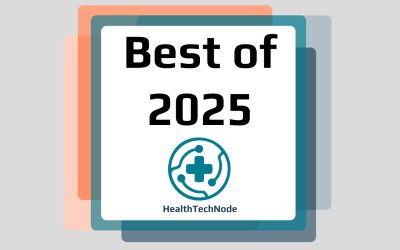How Awards Influence Adoption and Investment in HealthTech
 Award wins aren’t window dressing in HealthTech—they’re market signals that shape adoption and capital allocation. In a category where buyers manage clinical risk, security, compliance, and budget pressure, credible third-party recognition can compress time-to-trust, smooth procurement, and catalyze the analyst/partner flywheel. For investors, awards are weak-to-moderate priors that, paired with evidence, help underwrite traction, team quality, and go-to-market efficiency. This guide explains the mechanisms at work and how to turn recognition into measurable adoption and fundraising outcomes.
Award wins aren’t window dressing in HealthTech—they’re market signals that shape adoption and capital allocation. In a category where buyers manage clinical risk, security, compliance, and budget pressure, credible third-party recognition can compress time-to-trust, smooth procurement, and catalyze the analyst/partner flywheel. For investors, awards are weak-to-moderate priors that, paired with evidence, help underwrite traction, team quality, and go-to-market efficiency. This guide explains the mechanisms at work and how to turn recognition into measurable adoption and fundraising outcomes.
Why awards matter in HealthTech
Healthcare decision makers are professional skeptics. They weigh clinical effectiveness, patient safety, data protection, uptime, and budget fit—often across committees. Awards from programs those committees trust act as third-party validation that your claims merit a closer look. The result is momentum: more replies, faster champion mobilization, and fewer internal objections to pilot or purchase.
Adoption mechanisms inside provider & payer organizations
Recognition works by lowering perceived risk and increasing internal advocacy. Champions can reference a respected award when socializing your solution with compliance and clinical stakeholders. That external proof, placed in your security one-pager and executive slides, helps reframe you from “unproven vendor” to “validated option,” which shortens the path to sandbox access, pilot scope, and go-live approvals.
Evidence, clinical governance & responsible AI
Awards are most persuasive when they map to outcomes and method. Couple the win with succinct evidence: baseline versus lift, cohort definitions, confidence intervals where relevant, and guardrails for AI or automation in clinical workflows. A one-page “evidence sheet” that cites data sources, human-in-the-loop checkpoints, and post-market monitoring turns a badge into governance-ready proof.
Risk, security & compliance signals in procurement
InfoSec and legal reviewers look for indicators you’ll be a low-surprise vendor. Use the award moment to package attestations (e.g., SOC/ISO), SBOM highlights, access controls, RTO/RPO targets, and tabletop results. When these artifacts ride alongside credible recognition, diligence cycles typically shorten and objections shift from “can we trust this?” to “how do we implement well?”
 Analyst, media & partner network effects
Analyst, media & partner network effects
Award announcements spark coverage and links that compound visibility. Analyst teams are likelier to accept briefings; platform and marketplace partners are more receptive to listings or co-marketing. The amplification matters: a single win can cascade into domain authority gains, partner exposure, and additional customer references—inputs that further accelerate adoption.
From pilot to scale: speeding the adoption curve
Recognition helps cross the credibility gap between pilot and enterprise rollout. Executives are more comfortable committing budget when results are externally validated. Use the win to tighten your rollout playbook—reference design sites, change-management steps, clinical safety checks, and training assets—so pilots convert to multi-site or enterprise contracts faster.
Investment implications: how awards shape fundraising
For investors, awards are a screening heuristic. Alone, they don’t guarantee product-market fit, but they can upgrade perception of execution quality and go-to-market leverage. When paired with evidence—win-backed case studies, enterprise logos, and improving sales efficiency—awards can support better terms or shorter diligence for Seed through Series B, and help later-stage funds underwrite category leadership.
What signals investors actually read
Investors look past the logo. They scan for causal links: did your win precede measurable uplift in meeting accepts, stage conversion, or pricing discipline? Are there net-new analyst mentions, marketplace listings, or partner campaigns? Do customers cite the award in their internal approvals? The tighter your attribution and the cleaner your dashboards, the stronger the signal.
Pitfalls: vanity awards & pay-to-play traps
Not all recognition helps. Programs your buyers don’t recognize, or that hinge on sponsorship spend rather than merit, can dilute credibility. Avoid broad “best startup” lists with no methodology. Prioritize awards with clear criteria, expert judges, and categories aligned to outcomes you can prove. Fewer, stronger wins activated well will beat a long list of weak badges.
Measurement: attributing impact to an award
Track the levers an award should influence: reply and meeting-accept rates in outbound, stage-to-stage conversion and cycle time, average discount at close, referral traffic and backlinks, analyst/partner touchpoints, and hiring metrics. Use simple pre/post cohorts (e.g., 90 days) and annotate your CRM and analytics with the announcement date. Directional lift across multiple signals is the story investors and executives want.
Your 30/60/90-day activation plan
Days 0–30: Publish & enable
Announce in the newsroom, add a homepage badge, update product pages and your security one-pager, and equip execs with a short LinkedIn kit. Brief top partners and one analyst group while attention is fresh.
Days 31–60: Prove & promote
Host a customer mini-webinar on the outcome story, publish a “why we won” explainer, and A/B test award-referencing subject lines in outbound. Add the badge to late-stage nurture content and procurement packets.
Days 61–90: Scale & systematize
Bundle the award with a case study for late-stage deals, add it to RFP boilerplate, and run a light ROI read-out. Use the findings to choose the next two to four programs your buyers respect.
FAQs
Do investors actually care about awards?
Yes—mostly as a corroborating signal. Pair the win with evidence (logos, outcomes, sales efficiency) to make it material in fundraising.
Which awards influence provider adoption the most?
Programs your buyers already trust and that align to clinical, operational, or security outcomes. Methodology and judging credibility matter more than brand alone.
How do we prove an award moved the needle?
Annotate the announcement date in your CRM and web analytics, then compare 60–90-day pre/post cohorts for reply rate, stage conversion, cycle time, discounting, referral traffic, and analyst/partner activity.In HealthTech, awards are not decoration—they’re operating leverage. When you choose credible programs, anchor your entry in outcomes, and package the win with evidence (security posture, clinical results, efficiency gains), recognition becomes a signal that shortens time-to-trust, speeds procurement, improves pricing discipline, and strengthens your investor narrative. Treat the announcement as the start, not the finish: enable sales, brief partners and analysts, annotate the date in your CRM and analytics, and measure pre/post lift across reply rates, stage conversion, cycle time, discounting, and referrals. Do this consistently and awards will compound into adoption—and the kind of traction that attracts capital on better terms.
Latest News and Updates
Entries Open for the 2026 Global HealthTech Impact Award
Entries are open for HealthTechNode’s 2026 Global HealthTech Impact Award, honoring solutions that expand access, improve outcomes, and advance equity worldwide. Apply by January 16.
Best of 2025 HealthTechNode Awards Are Now Open
HealthTechNode’s inaugural Best of 2025 Awards are open. Enter by Nov 14 for Early Bird, final deadline Jan 9, winners announced Feb 9. Recognition, visibility, and PR.
Why HealthTech Awards Matter for Startups and Scaleups
Awards aren’t vanity—they’re operating tools. This guide shows how recognition drives enterprise trust, PR/SEO, hiring, and investor confidence, plus how to win and activate it.

 Analyst, media & partner network effects
Analyst, media & partner network effects

